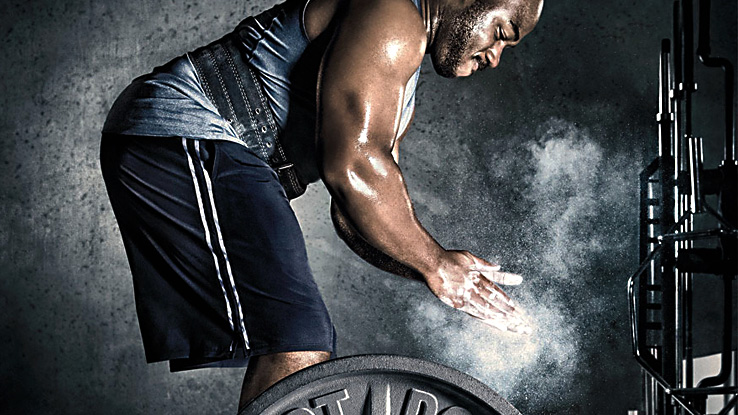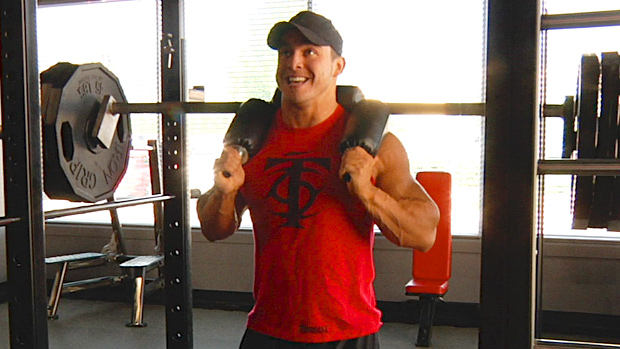Want to experience the latest in fast muscular growth? Sure you do. But are you up to this challenge? Fewer than half could hack it the first time around.
Two years ago, I presented a bold proposition to the readers of T-Nation:
"Give me four workouts in 14 days . . . and I'll give you 3/8 of an inch growth on each of your upper arms."
One hundred and six guys signed up to go through the following routine:
- Extremely slow chin-up (at least 30 seconds up and 30 seconds down), 1 repetition only, immediately followed by:
- Biceps curls with barbell, 8-12 reps
(immediately followed, in week 2, by negative-only chin-ups, 8 reps)
- Rest briefly.
- Extremely slow dip (at least 30 seconds up and 30 seconds down), 1 repetition only, immediately followed by:
- Triceps extensions with one dumbbell, 8-12 reps
(immediately followed, in week 2, by negative-only dips, 8 reps).
The participants did the 4-exercise cycle twice in week 1, and the 6-exercise cycle twice in week 2. Then, each subject compared his before-and-after contracted arm measurements and photographs, and e-mailed them to me.

Because of the intensity of the routine, I expected a few dropouts. I didn't expect sixty-six dropouts. Can you believe it? Only forty trainees were man enough to stick with the program until the end. With an overall body weight increase of slightly less than one pound on average, the average gain for each arm was 0.21 inch (compared to an expected gain of 0.375 inch).
Well, "wrong" may be too harsh a word, since 0.21 inch is still measurable muscular growth, after all, and some guys actually exceeded the promised 0.375 inch.
Nevertheless, here's what I believe occurred:
First, the intensity of the slow chin-up and slow dip surprised a lot of trainees. At 30 seconds up and 30 seconds down, it was simply too difficult for the majority.
Second, optimum performance in the chin-up, dip, and other exercises required a partner to help with the counting and, perhaps most importantly, push the trainee to assure maximum effort and thus optimum growth stimulation. Without the correct supervision, if you screw up on just one workout out of four, it can dramatically taint the results.

Third, my observation was that the fourth workout was right on the borderline of being too much, when stacked with the first three. It was counter-productive and led to overtraining of the biceps and triceps in some participants. Overall, three workouts in 10 days would have been better than 4 workouts in 14 days.
Fourth, the taking of before-and-after photos, in a standardized manner, baffled some trainees and contributed to them dropping out.
Thus, in this revised and improved Bigger Arms Challenge, I've modified the exercises and made the routine more applicable. At the same time, I've kept the intensity and most of the form and style. Lastly, this time around I'm going to insist that you have a good training partner and a basic understanding of getting photos with a digital camera.
With that said, let's examine the mechanics of why this new program works.
I've spent more than 40 years testing and retesting various arm routines. I've found that for maximum growth of the biceps and triceps in a short period of time, you need to apply five factors:
- Exercises
- Style of Training
- Slowness
- Recovery
- Supervision
1. Exercises
Building really big biceps and triceps require a combination of single-joint and multiple-joint movements. By single joint I mean that the elbow remains stable and the forearm and hand move. Examples for the biceps are curls with a barbell and dumbbell. Examples for the triceps are extensions with a barbell and dumbbell.
Multiple-joint exercises for the biceps and triceps are those that permit the elbow to move and movement occurs around both the elbow and the shoulder. Examples for the biceps are bent-over rows with a barbell or dumbbell, chin-ups, and pulldowns on a lat machine. Examples for the triceps are bench presses with a barbell, overhead presses with a barbell, and dips.
From my experience, the best conventional exercises for the upper arms are standing barbell curls, chin-ups, standing triceps extensions with one dumbbell held in both hands, and dips.
2. Style of Training
This subheading includes such concepts as progression, accentuation of the negative, and double pre-exhaustion. Progression means trying to increase the repetitions or resistance in each exercise each time you train. Proper progression requires strict form and great intensity. Placing more emphasis on the negative or lowering phase of each exercise is helpful in causing greater growth stimulation. Perhaps the best technique to apply for your upper arms is called double pre-exhaustion, which stacks three exercises: multiple joint, single joint, and multiple joint.
3. Slowness
By slowness I mean that the lifting and lowering should be very deliberate. Remove as much momentum as you can from your exercise and the targeted muscles will be more thoroughly involved. In fact, extremely slow, 30- to 60-second negatives can occlude blood flow to the working muscles. Limited occlusion leads to severe muscular burning and extreme muscular pumps, which can induce additional growth stimulation.
4. Recovery
Most trainees neglect recovery. They perform too many exercises and too many sets, too frequently. As a result, they fail in the departments of enough rest and sleep. Muscles, by their break-down/build-up nature, require plenty of down time to overcompensate and become bigger and stronger. At least 8 hours of sleep per night is essential, and more if you're a teenager. One food supplement that definitely aids in the recovery process is creatine monohyrate.
5. Supervision
If you're serious about getting the most out of your training, especially three workouts in 10 days, getting someone to help you excel on each exercise is absolutely essential. That someone, be it an actual training partner, a buddy, a brother, or even your wife or girlfriend, must be able to spot you, count time and reps, talk you through that last repetition in good form, and record accurately what you've done on each exercise.
Don't treat this factor lightly. Choose that person wisely. Can you do the 10-day program without having a training partner? Sure, but you'll probably be sacrificing your best-possible results.
Spend some time thinking about what I said about supervision, recovery, slowness, and style of training. For now, however, let's take a look at the exercises for the new routine. After the exercise descriptions, I'll get into the details that are required for you to participate.
There are three exercises in the biceps cycle, and three exercises in the triceps cycle. Compared to the old routine, the first exercise in each cycle is shorter and the last exercise is simplified but longer. Here's the revised and improved arm routine:
- Chin-up, 1 repetition only, 15 seconds up and 15 seconds down, immediately followed by:
- Standing biceps curl with barbell, 8-12 reps, immediately followed by:
- Very slow negative-only chin-up, 1 repetition only, 30-60 seconds down.
- Rest for 2 minutes.
- Dip, 1 repetition only, 15 seconds up and 15 seconds down, immediately followed by:
- Standing triceps extension with one dumbbell held in both hands, 8-12 reps, immediately followed by
- Very slow negative-only dip, 1 repetition only, 30-60 seconds down.
Chin-up, 1 repetition only
This movement prepares you for the two hardest exercises. With an underhand position, grasp a horizontal bar with your hands shoulder-width apart. Hang with your arms fully extended, lift your feet off the floor, and pause. This is your starting position.
Note: make sure the horizontal bar you're holding on to is stationary. It's not to your advantage for it to move, rotate, or revolve.
Have your training partner or assistant, who has a watch with a second hand, give you the command "Go!". Smoothly begin bending your elbows and moving your body upward. At the count of 7 seconds, you should be halfway up. Keep your movement slow and deliberate and reach the top, with your chin over and your upper chest touching the bar, at 15 seconds.
Once you've achieved the top position, lower yourself in exactly the same manner. Again, your assistant should be giving you a time count on the way down. Come to a dead hang at exactly 15 seconds.
Stand and immediately move to the biceps curl with a straight bar.
Standing biceps curl with barbell
This is a standing barbell curl performed strictly. To be conservative, lower your normal curling resistance by 20 percent. Grasp the barbell with your palms up and your hands shoulder-width apart. Stand erect, anchor your elbows firmly against the sides of your waist, and try to keep them anchored throughout the exercise.
Curl the barbell smoothly, while keeping your body vertical. Don't lean forward or backward. Lower the weight slowly, remembering to keep your elbows stable. Keep the speed at approximately 2 seconds on the positive and 2 seconds on the negative. Don't pause at the bottom. Begin the next repetition instantly. Repeat for maximum repetitions in the 8 to 12 range.
Focus on getting one more repetition, even when it looks like you won't succeed. Accept the pain and then ignore it. Most trainees quit when in fact they have one or two reps left in them. When you finally fail, move quickly back to the chinning bar.
Very slow negative-only chin-up
This is a difficult exercise, and one that few bodybuilders have ever tried. The object is to use your legs to climb up (place a chair or bench under the chinning bar) to the top position and do a single lowering repetition. There are no positive reps involved. It's all negative. The goal: 60 seconds. 60 seconds of excruciatingly slow downward movement. Most trainees initially will be lucky to get 30 to 40 seconds.

Right from the start, this exercise will be brutally hard, particularly if you complete your curls next to the chinning bar, where you can go from one to the other in less than three seconds. By now, you'll already have a decent pump in your biceps and this slow chin will occlude most of the blood flow and make your biceps cry for mercy. With great focus and your training partner calling out the seconds: 5, 10, 15, 20, 25, halfway down, and so on, your biceps will be forced to respond like never before.
One helpful hint is to divide the downward movement into a series of 12, one-inch segments. Then, your partner paces you with his 5-second callouts as you begin your holds and descends, all the way to a dead hang at the bottom.
Climb quickly to the top. With your palms up and your hands shoulder-width apart, hold steady. Start your inch-by-inch, negative-only chin-up, and you'll be on your way to the best pump in your life.
Rest for 2 minutes
Get a quick drink of water, shake and massage your biceps and forearms a bit, and ready yourself for the dip.
Dip, 1 repetition only
The 1-repetition dip is performed in a similar way as the 1-repetition chin-up. Start the dip in the bottom, stretched position. Take 15 seconds to push smoothly to the top and an equal amount of time to lower. After the last few seconds of lowering, step down, pick up a properly loaded dumbbell (40 pounds may be about right), and ready yourself for the triceps extensions.
Triceps extensions
Hold a single dumbbell at one end with both hands and press it overhead. Stabilize your elbows close to your ears as you lower the dumbbell behind your head. Keep your upper arms vertical; only your forearms and hands should move. Extend the dumbbell back to the top position and continue at a speed of 2 seconds on the positive and 2 seconds on the negative for 8 to 12 reps. Remember to always try for one more repetition. Focus on the triceps pain, and tolerate it.
After the last rep, put the dumbbell onto the floor, and immediately position yourself under the parallel bars.
Very slow negative-only dip

This is your mass-making finisher so don't cut it short. Climb quickly to the top position of the dip. Remove your feet and begin the extremely slow descent. Your goal, once again, is 60 seconds. Divide the dip into 12 one-inch segments, and begin. Make sure your timekeeper gives you an ongoing count after each 5 seconds. At the 30-second, halfway point it should become brutally intense. Keep your face relaxed and endure the pain. Don't drop. Breathe continuously and stay focused.
Note: once again, it's very important to take little or no rest between the three triceps exercises. I know you're going to be in pain and puffing like an old-fashioned freight train, before and during the very slow dip. Accept the challenge and deal with it aggressively. That's what it takes to stimulate fast muscular growth.
To be a part of the revised and improved Bigger Arms Challenge, you need to take the following steps:
Note: Some of you may want to go through the challenge without signing up. But I've found that you'll be much more motivated and get better results if you're part of a group that experiences the same routine on the same days. Let's stick together and get the best-possible gains.
- Make a commitment. Tell me that you want to be involved by posting a note in the Article Discussion section of the Testosterone Forums. Include your age, height, and weight. All previous challenge participants are especially welcome to join.
- Have a friend with a digital camera take before-and-after shots of your contracted arms in a double-biceps pose. Try to standardize the photos: same background, angle and distance from the camera, and time of day. At the end of the plan, post the pics. If you don't want to be recognized, wear dark glasses, do the photos from the backside, or crop out your head.
- Agree to train your biceps and triceps, according to the outlined directions, three times over a 10-day period.
- Take a careful set of Before circumference measurements of your upper arms in the following manner: Locate a thin plastic tape. Have a training partner take your un-pumped measurements prior to exercising. Stand and contract your right biceps. Your upper arm should be parallel to the floor. Have your buddy pass the tape around the largest part of the biceps with the tape perpendicular to the upper-arm bone. The tape should be taut but not tight. Record the measurement to the nearest one-eighth of an inch. Measure the left biceps in the same manner.
- Try a practice session with the slow chin and dip. Doing each movement requires a little learning. Make sure you place a barbell for the biceps curl next to the chinning bar and a dumbbell for the triceps extension near the parallel bars. In each cycle, it's important to move quickly from one exercise to the next.
- Find a reliable training partner. I've already mentioned why it's so crucial.
- Begin your initial workout on Tuesday, March 11th, 2008. If there's a problem, you could also start on the next day. Your second workout is on March 14th and your third is on March 17th. Allow approximately 72 hours between workouts. So, ideally you'll be exercising on Tuesday, Friday, and Monday (of the next week).
- Important! Add four non-arm exercises to complete your workout on each training day. I suggest squats with a barbell or leg presses on a machine; some form of calf raises; lateral raises with dumbbells; and shoulder shrugs with a barbell or dumbbells. Use as much resistance as you can handle for one set of 8 to 12 repetitions. Do these four exercises after your arm cycles.
- Be progressive in all your exercises (with the exception of the 1-rep chin-up and 1-rep dip, where they remain at 15 seconds up and 15 seconds down for all three workouts). Increase the resistance by 5 percent on any exercise that you can achieve 12 or more repetitions on. Add 5-10 seconds on the negative-only chin and dip for your second and third workouts.
- Limit your strenuous activity on your off days. Also, get more rest and sleep, if possible. The idea is to hit your biceps and triceps hard, then back off and permit them to grow larger.
- Eat nutritiously and don't skimp on calories.
- Use creatine monohydrate (I like Biotest's version) according to directions on the label for two weeks. Research shows that creatine contributes to recovery and muscle-fiber growth.
- Complete your third arm-training session on March 17th. Rest over the next two days. On the morning of March 20th, re-measure your contracted right and left biceps and record each to the nearest one-eighth of an inch. Also, have your training partner take another picture of your contracted arms in a double-biceps pose.
- Post your Before and After measurements and your Before and After double-biceps pictures in the appropriate thread on T-Nation.
Over the next several weeks, I'll be hanging close to the T-Nation discussion board to take your comments and questions and offer my guidelines and suggestions.
I believe this new upper-arm routine is an improvement over the older one. If you supply your best effort for three workouts, you'll be rewarded with significant size increases on your biceps and triceps.
Accept my challenge, commit now, and let's make it happen.




